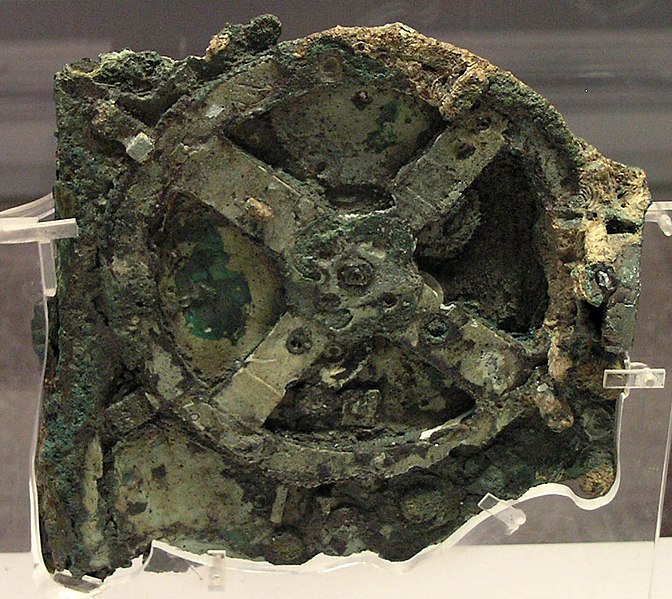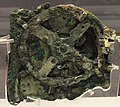ꯐꯥꯏꯜ:NAMA Machine d'Anticythère 1.jpg

ꯃꯁꯤꯒꯤ ꯄ꯭ꯔꯚꯤꯌꯨ ꯑꯁꯤꯒꯤ ꯁꯥꯏꯓ: ৬৭২ × ৫৯৯ ꯄꯤꯛꯆꯦꯜꯁ. ꯑꯇꯩ ꯁꯦꯡꯅ ꯌꯦꯡꯕ ꯌꯥꯕ: ২৬৯ × ২৪০ ꯄꯤꯛꯆꯦꯜꯁ | ৫৩৮ × ৪৮০ ꯄꯤꯛꯆꯦꯜꯁ | ৮৬১ × ৭৬৮ ꯄꯤꯛꯆꯦꯜꯁ | ১,০৩৬ × ৯২৪ ꯄꯤꯛꯆꯦꯜꯁ.
ꯐꯥꯏꯜ ꯑꯁꯦꯡꯕ (১,০৩৬ × ৯২৪ ꯄꯤꯛꯆꯦꯜꯁ, ꯐꯥꯏꯜ ꯆꯥꯎꯕꯒꯤ ꯆꯥꯡ: ২০৭ KB, MIME ꯃꯈꯜ: image/jpeg)
ꯐꯥꯏꯜꯒꯤ ꯄꯨꯋꯥꯔꯤ
ꯆꯩꯆꯠ/ꯃꯇꯝꯗ ꯅꯝꯃꯨ ꯃꯇꯝ ꯑꯗꯨꯗ ꯐꯥꯏꯜ ꯑꯗꯨ ꯎꯅꯕ
| ꯆꯩꯆꯠ/ꯃꯇꯝ | ꯈꯨꯠꯄꯤꯈꯨꯖꯤꯟ | ꯄꯥꯛ ꯆꯥꯎꯕꯥ | ꯁꯤꯖꯤꯟꯅꯔꯤꯕ | ꯑꯄꯥꯝꯕ ꯐꯣꯡꯗꯣꯛ ꯎ | |
|---|---|---|---|---|---|
| ꯍꯧꯖꯤꯛꯀꯤ | ꯱꯶:꯱꯸, ꯲꯰ ꯗꯤꯁꯦꯝꯕꯔ ꯲꯰꯰꯵ |  | ১,০৩৬ × ৯২৪ (২০৭ KB) | Marsyas | Fragment principal de la machine d'Anticythère. Le mécanisme consiste en un système complexe de 32 roues et plaques portant des inscriptions relatives aux signes du zodiac et aux mois. L'étude des fragments suggère qu'il s'agissait d'une sorte d'astr |
ꯐꯥꯏꯜꯒꯤ ꯁꯤꯖꯤꯟꯅꯐꯝ
ꯃꯇꯨꯡ ꯏꯟꯕ 3ꯂꯃꯥꯏ ꯁꯤꯖꯤꯟꯅꯕ ꯃꯁꯤꯒꯤ ꯐꯥꯏꯜ:
ꯃꯥꯂꯦꯝꯒꯤ ꯊꯥꯛꯇꯥ ꯁꯤꯖꯤꯟꯅꯕꯥ ꯐꯥꯏꯜ
ꯃꯁꯤꯒꯤ ꯐꯥꯏꯜ ꯑꯁꯤ ꯃꯈꯥꯒꯤ ꯑꯇꯩ ꯋꯤꯀꯤꯁꯤꯡꯅ ꯁꯤꯖꯤꯟꯅꯩ:
- ab.wikipedia.org ꯗꯥ ꯁꯤꯖꯤꯟꯅꯩ
- af.wikipedia.org ꯗꯥ ꯁꯤꯖꯤꯟꯅꯩ
- als.wikipedia.org ꯗꯥ ꯁꯤꯖꯤꯟꯅꯩ
- ang.wikipedia.org ꯗꯥ ꯁꯤꯖꯤꯟꯅꯩ
- anp.wikipedia.org ꯗꯥ ꯁꯤꯖꯤꯟꯅꯩ
- an.wikipedia.org ꯗꯥ ꯁꯤꯖꯤꯟꯅꯩ
- ar.wikipedia.org ꯗꯥ ꯁꯤꯖꯤꯟꯅꯩ
- ast.wikipedia.org ꯗꯥ ꯁꯤꯖꯤꯟꯅꯩ
- azb.wikipedia.org ꯗꯥ ꯁꯤꯖꯤꯟꯅꯩ
- az.wikipedia.org ꯗꯥ ꯁꯤꯖꯤꯟꯅꯩ
- bcl.wikipedia.org ꯗꯥ ꯁꯤꯖꯤꯟꯅꯩ
- be-tarask.wikipedia.org ꯗꯥ ꯁꯤꯖꯤꯟꯅꯩ
- be.wikipedia.org ꯗꯥ ꯁꯤꯖꯤꯟꯅꯩ
- bg.wikipedia.org ꯗꯥ ꯁꯤꯖꯤꯟꯅꯩ
- bn.wikipedia.org ꯗꯥ ꯁꯤꯖꯤꯟꯅꯩ
- bs.wikipedia.org ꯗꯥ ꯁꯤꯖꯤꯟꯅꯩ
- ca.wikipedia.org ꯗꯥ ꯁꯤꯖꯤꯟꯅꯩ
- ce.wikipedia.org ꯗꯥ ꯁꯤꯖꯤꯟꯅꯩ
- cs.wikipedia.org ꯗꯥ ꯁꯤꯖꯤꯟꯅꯩ
- cv.wikipedia.org ꯗꯥ ꯁꯤꯖꯤꯟꯅꯩ
ꯌꯦꯡꯉꯨ ꯃꯂꯦꯝꯒꯤ ꯊꯥꯛꯀꯤ ꯁꯤꯖꯤꯟꯅꯐꯝ ꯑꯗꯨ ꯃꯁꯤꯒꯤ ꯐꯥꯏꯜꯁꯤꯗ ꯫

